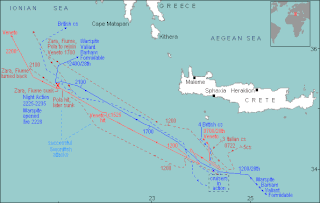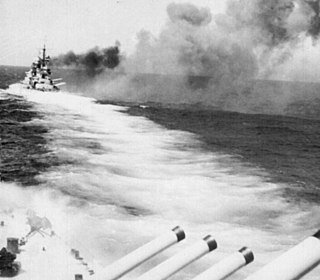
The Battle of Cape Matapan was a naval battle during the Second World War between the Allies, represented by the navies of the United Kingdom and Australia, and the Royal Italian navy, from 27 to 29 March 1941. Cape Matapan is on the south-western coast of the Peloponnesian peninsula of Greece.

The attack on Mers-el-Kébir on 3 July 1940, during the Second World War, was a British naval attack on French Navy ships at the naval base at Mers El Kébir, near Oran, on the coast of French Algeria. The attack was the main part of Operation Catapult, a British plan to neutralise or destroy French ships to prevent them from falling into German hands after the Allied defeat in the Battle of France. The British bombardment of the base killed 1,297 French servicemen, sank a battleship and damaged five other ships, for a British loss of five aircraft shot down and two crewmen killed. The attack by air and sea was conducted by the Royal Navy, after France had signed armistices with Germany and Italy, coming into effect on 25 June.

The Battle of Calabria known to the Italian Navy as the Battle of Punta Stilo, was a naval battle during the Battle of the Mediterranean in the Second World War. Ships of the Regia Marina were opposed by vessels of the Mediterranean Fleet. The battle took place 30 nmi to the east of Punta Stilo, Calabria.

The Second Battle of Sirte was a naval engagement in the Mediterranean Sea, north of the Gulf of Sidra and south-east of Malta, during the Second World War. The escorting warships of a British convoy to Malta held off a much more powerful squadron of the Regia Marina. The British convoy was composed of four merchant ships, escorted by four light cruisers, one anti-aircraft cruiser and 17 destroyers. The Italian force comprised a battleship, two heavy cruisers, one light cruiser and ten destroyers. Despite the British success at warding off the Italian squadron, the Italian fleet attack delayed the convoy's planned arrival before dawn, which exposed it to intense air attacks that sank all four merchant ships and one of the escorting destroyers in the following days.

Vittorio Veneto was the second member of the Littorio-class battleship that served in the Italian Regia Marina during World War II. The ship's keel was laid down in October 1934, launched in July 1937, and readied for service with the Italian fleet by August 1940. She was named after the Italian victory at Vittorio Veneto during World War I, and she had three sister ships: Littorio, Roma, and Impero, though only Littorio and Roma were completed during the war. She was armed with a main battery of nine 381-millimeter (15.0 in) guns in three triple turrets, and could steam at a speed of 30 knots.

The Battle of the Mediterranean was the name given to the naval campaign fought in the Mediterranean Sea during World War II, from 10 June 1940 to 2 May 1945.

Angelo Iachino was an Italian admiral during World War II.

Trieste was the second of two Trento-class heavy cruisers built for the Italian Regia Marina. The ship was laid down in June 1925, was launched in October 1926, and was commissioned in December 1928. Trieste was very lightly armored, with only a 70 mm (2.8 in) thick armored belt, though she possessed a high speed and heavy main battery of eight 203 mm (8 in) guns. Though nominally built under the restrictions of the Washington Naval Treaty, the two cruisers significantly exceeded the displacement limits imposed by the treaty. The ship spent the 1930s conducting training cruises in the Mediterranean Sea, participating in naval reviews held for foreign dignitaries, and serving as the flagship of the Cruiser Division. She also helped transport Italian volunteer troops that had been sent to Spain to fight in the Spanish Civil War return to Italy in 1938.

Trento was the first of two Trento-class cruisers; they were the first heavy cruisers built for the Italian Regia Marina. The ship was laid down in February 1925, launched in October 1927, and was commissioned in April 1929. Trento was very lightly armored, with only a 70 mm (2.8 in) thick armored belt, though she possessed a high speed and heavy main battery of eight 203 mm (8 in) guns. Though nominally built under the restrictions of the Washington Naval Treaty, the two cruisers significantly exceeded the displacement limits imposed by the treaty.

The First Battle of Sirte was fought between forces of the British Mediterranean Fleet and the Regia Marina during the Battle of the Mediterranean in the Second World War. The engagement took place on 17 December 1941, south-east of Malta, in the Gulf of Sirte. The engagement was inconclusive as both forces were protecting convoys and wished to avoid battle.

Operation Collar was a small, fast three-ship convoy during the Second World War. The convoy left Britain on 12 November 1940 and passed Gibraltar on 24 November, escorted by two cruisers, two ships for Malta and one bound for Alexandria. Numerous other operations took place partly as diversions and the Italian Fleet sailed to attack British ships, leading to the inconclusive Battle of Cape Spartivento on 27 November. The two merchant ships reached Malta on 26 November.

Operation Vigorous was a British operation during the Second World War, to escort supply convoy MW11 from the eastern Mediterranean to Malta, which took place from 11 to 16 June 1942. Vigorous was part of Operation Julius, a simultaneous operation with Operation Harpoon from Gibraltar and supporting operations. Sub-convoy MW11c sailed from Port Said (Egypt) on 11 June, to tempt the Italian battlefleet to sail early, use up fuel and be exposed to submarine and air attack. MW11a and MW11b sailed next day from Haifa, Port Said and Alexandria; one ship was sent back because of defects. Italian and German (Axis) aircraft attacked MW11c on 12 June and a damaged ship was diverted to Tobruk, just east of Gazala. The merchant ships and escorts rendezvoused on 13 June. The British plans were revealed unwittingly to the Axis by the US Military Attaché in Egypt, Colonel Bonner Fellers, who reported to Washington, D.C. in "Black"-coded wireless messages; it was later discovered that the Black Code had been broken by the Servizio Informazioni Militare.

Operation Halberd was a British naval operation that took place on 27 September 1941, during the Second World War. The British were attempting to deliver a convoy from Gibraltar to Malta. The convoy was escorted by several battleships and an aircraft carrier, to deter interference from the Italian surface fleet, while a close escort of cruisers and destroyers provided an anti-aircraft screen.

HMS Gloucester was one of the second batch of three Town-class light cruisers built for the Royal Navy during the late 1930s. Commissioned shortly before the start of World War II in August 1939, the ship was initially assigned to the China Station and was transferred to the Indian Ocean and later to South Africa to search for German commerce raiders. She was transferred to the Mediterranean Fleet in mid-1940 and spent much of her time escorting Malta Convoys. Gloucester played minor roles in the Battle of Calabria in 1940 and the Battle of Cape Matapan in 1941. She was sunk by German dive bombers on 22 May 1941 during the Battle of Crete with the loss of 722 men out of a crew of 807. Gloucester acquired the nickname "The Fighting G" after earning five battle honours in less than a year.

Carlo Bergamini was an Italian admiral.

Operation MB8 was a British Royal Navy operation in the Mediterranean Sea from 4 to 11 November 1940. It was made up of six forces comprising two aircraft carriers, five battleships, 10 cruisers and 30 destroyers, including much of Force H from Gibraltar, protecting four supply convoys. It consisted of Operation Coat, Operation Crack, Convoy MW 3, Convoy ME 3, Convoy AN 6 and the main element Operation Judgement.

The Action in the Strait of Otranto [also the Battle of the Strait of Otranto (1940)] was the destruction of an Italian convoy on 12 November 1940 during the Battle of the Mediterranean in the Second World War. It took place in the Strait of Otranto in the Adriatic Sea, between the Royal Navy and the Italian Royal Navy.

Pola was a Zara-class heavy cruiser of the Italian Regia Marina, named after the Italian city of Pola. She was built in the Odero Terni Orlando shipyard in Livorno in the early 1930s and entered service in 1932. She was the fourth and last ship in the class, which also included Zara, Fiume, and Gorizia. Compared to her sisters, Pola was built as a flagship with a larger conning tower to accommodate an admiral's staff. Like her sisters, she was armed with a battery of eight 203-millimeter (8.0 in) guns and was capable of a top speed of 32 knots.

Fiume was a Zara-class heavy cruiser of the Italian Regia Marina, named after the Italian city of Fiume, she was the second of four ships in the class, and was built between April 1929 and November 1931. Armed with a main battery of eight 8-inch (200 mm) guns, she was nominally within the 10,000-long-ton (10,000 t) limit imposed by the Washington Naval Treaty, though in reality she significantly exceeded this figure.
Force B was the name of several British Royal Navy task forces during the Second World War.



















